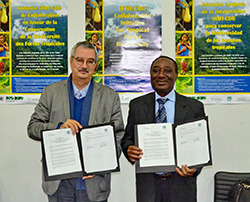Commitment renewed for tropical forest biodiversity
17 October 2014

CBD Executive Secretary, Dr. Braulio Dias, and ITTO Executive Director, Mr. Emmanuel Ze Meka renewed the two organization's commitment to preserve biodiversity in tropical forests. Photo: J. Leigh, ITTO
The key purpose of this MOU is to identify, develop and implement targeted joint activities on tropical forests and tropical forest biodiversity between the ITTO and CBD Secretriat. The MOU was originally signed in 2010 for the initial period of five years and renewed in Pyeongchang to extend its duration until 2020.
One of the major joint activities under the MOU is the ITTO/CBD Joint Collaborative Initiative on Tropical Forest Biodiversity. In the framework of the Initiative, 11 projects have been implemented to date in 26 ITTO producer member countries.
The ITTO/CBD Initiative has an estimated budget of US$ 15 million for the initial four years. A total of about US$ 12.5 million has been contributed to date by Japan, Switzerland, USA, Belgium, Republic of Korea and Japan Lumber Importers’ Association (JLIA) to implement those 11 projects.
Mr. Ze Meka stated in his opening address that “the Initiative is contributing to the achievement of the Strategic Plan for Biodiversity 2011-2020, in particular the forest-related Aichi Biodiversity Targets”. Dr. Dias also mentioned in his remarks before the signing that “the Initiative is a concrete example of actions on the ground to that end”.
The signing ceremony was followed by a series of presentations and a facilitated discussion on the ITTO/CBD Initiative. To provide the participants with an overview of the Initiative, Mr. John Leigh, Project Manager of ITTO gave a presentation. Then, four experts having been engaged in the implementation of projects under the ITTO/CBD Initiative shared their experiences and lessons learned with the participants.
Mr. Chheang Dany from Cambodia provided an insight into a project, “Trans-boundary Biodiversity Conservation in the Emerald Triangle Protected Forest Complex between Cambodia, Lao PDR and Thailand”, including the cross-border collaboration between the tree countries. Referring to the project outputs, he demonstrated their contribution to the achievement of Aichi Biodiversity Targets 1, 2, 5, 7, 11 and 15. He pointed out the importance of having a common vision and a political commitment in prior to the project implementation for successful transboundary conservation.
Ms. Yani Septiani from Indonesia presented on a project, “Promoting biodiversity conservation in Betung Kerihun National Park (BKNP) as the Trans-boundary Ecosystem between Indonesia and State of Sarawak Malaysia (Phase III)”. She elaborated how the project is contributing specifically to the achievement of the forest-related Aichi Biodiversity Targets, namely Targets 5, 7, 11 and 15. As a conclusion, she stressed that the keys to the successful conservation of forests and forest biodiversity include technical collaboration with all stakeholders and strengthened institutional capacity.
Mr. Pedro Lopes from Guatemala provided an overview of his project on behalf of HELVETAS, the executing agency of the “Integrated Management of Natural Resources and Biodiversity in the Tacana Volcano and Its Range of Influence in Mexico and Guatemala”. He mentioned that the project is contributing to the achievement of Aichi Biodiversity Targets 1, 5, 7, 12 and 14 through the implementation of a range of activities. The importance of supporting the livelihoods of local communities through bottom-up approach was also emphasized in his presentation.
Mr. Kenichi Shishido, Deputy Director General of the Global Environment Department of Japan International Cooperation Agency (JICA) illustrated a wide range of assistance JICA is providing for the conservation of tropical forest biodiversity worldwide. In his presentation, he highlighted the effectiveness of the combination of Japan’s large-scale financial contribution and on-site guidance provided by the Japanese experts for the smooth implementation of the ITTO/CBD Initiative. Mr. Shishido emphasized the value of synergy created through the collaboration between ITTO and JICA.
With the facilitation by Ms. Catalina Santamaria, Programme Officer of the CBD Secretariat, active discussions took place between the presenters and the facilitator. The exchange was geared by her question on how these projects can possibly be aligned toward the achievement of forest-related Aichi Biodiversity Targets. Then, the floor was opened to the audience. Questions were asked to the presenters for their views and suggestions for preventing cross-border poaching and promoting eco-tourism as well as the challenges toward sustaining project outcomes. The side event was attended by about 50 delegates and observers present at the CBD COP 12.
Aichi Biodiversity Targets:
Target 1: By 2020, at the latest, people are aware of the value of biodiversity and the steps they can take to conserve and use if sustainably;
Target 2: By 2020, at the latest, biodiversity values have been integrated into national and local development and poverty reduction strategies and planning processes and are being incorporated into national accounting, as appropriate, and reporting systems;
Target 5: By 2020, the late of loss of all natural habitats, including forests, is at least halved and where feasible brought close to zero, and degradation and fragmentation is significantly reduced;
Target 7: By 2020 areas under agriculture, aquaculture and forestry are managed sustainably, ensuring conservation of biodiversity;
Target 11: By 2020, at least 17 per cent of terrestrial and inland water, and 10 per cent of coastal and marine areas, especially areas of particular importance for biodiversity and ecosystem services, are conserved through effectively and equitably managed, ecologically representative and well connected systems of protected areas and other effective area-based conservation measures, and integrated into the wider landscapes and seascapes; and
Target 14: By 2020, ecosystems that provide essential services, including services related to water, and contribute to health, livelihoods and well-being, are restored and safeguarded, taking into account the needs of women, indigenous and local communities, and the poor and vulnerable.
Target 15: By 2020, ecosystem resilience and the contribution of biodiversity to carbon stocks has been enhanced, through conservation and restoration, including restoration of at least 15 per cent of degraded ecosystems, thereby contributing to climate change mitigation and adaptation and to combating desertification.